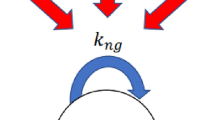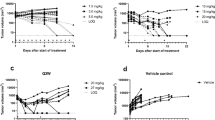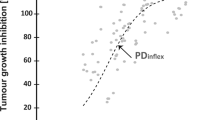Abstract
The mathematical modeling of tumor xenograft experiments following the dosing of antitumor drugs has received much attention in the last decade. Biomarker data can further provide useful insights on the pathological processes and be used for translational purposes in the early clinical development. Therefore, it is of particular interest the development of integrated pharmacokinetic–pharmacodynamic (PK–PD) models encompassing drug, biomarker and tumor-size data. This paper investigates the reciprocal consistency of three types of models: drug-to-tumor, such as established drug-driven tumor growth inhibition (TGI) models, drug-to-biomarker, e.g. indirect response models, and biomarker-to-tumor, e.g. the more recent biomarker-driven TGI models. In particular, this paper derives a mathematical relationship that guarantees the steady-state equivalence of the cascade of drug-to-biomarker and biomarker-to-tumor models with a drug-to-tumor TGI model. Using the Simeoni TGI model as a reference, conditions for steady-state equivalence are worked out and used to derive a new biomarker-driven model. Simulated and real data are used to show that in realistic cases the steady-state equivalence extends also to transient responses. The possibility of predicting the drug-to-tumor potency of a new candidate drug based only on biomarker response is discussed.
Access this article
We’re sorry, something doesn't seem to be working properly.
Please try refreshing the page. If that doesn't work, please contact support so we can address the problem.













Similar content being viewed by others
References
Poggesi I, De Nicolao G, Germani M, Rocchetti M (2009) Re: antitumor efficacy testing in rodents. J Natl Cancer I:101
Jusko WJ (1971) Pharmacodynamics of chemotherapeutic effects: dose-time-response relationships for phase-nonspecific agents. J Pharm Sci 60(6):892–895
Jusko WJ (1973) A pharmacodynamic model for cell-cycle-specific chemotherapeutic agents. J Pharm Biopharm 1(3):175–200
Bonate PL (2011) Modeling tumor growth in oncology. Pharmacokinetics in drug development. Springer, New York, pp 1–19
Simeoni M, De Nicolao G, Magni P, Rocchetti M, Poggesi I (2013) Modeling of human tumor xenografts and dose rationale in oncology. Drug Discov Today 10(3):e365–e372
Ribba B, Holford N, Magni P, Trocóniz I, Gueorguieva I, Girard P, Sarr C, Elishmereni M, Kloft C, Friberg L (2014) A review of mixed-effects models of tumor growth and effects of anticancer drug treatment used in population analysis. CPT Pharm Syst Pharmacol 3(5):e113
Simeoni M, Magni P, Cammia C, De Nicolao G, Croci V, Pesenti E, Germani M, Poggesi I, Rocchetti M (2004) Predictive pharmacokinetic-pharmacodynamic modeling of tumor growth kinetics in xenograft models after administration of anticancer agents. Cancer Res 64(3):1094–1101
Magni P, Simeoni M, Poggesi I, Rocchetti M, De Nicolao G (2006) A mathematical model to study the effects of drugs administration on tumor growth dynamics. Math Biosci 200(2):127–151
Atkinsons A, Colburn W, DeGruttola V, DeMets D, Downing G, Hoth D et al (2001) Biomarkers and surrogate endpoints: preferred definitions and conceptual framework. Biomarker definition working group. Clin Pharmacol Ther 69:89–95
Williams PJ, Ette E (2007) Biomarkers in drug development and pharmacometric modeling. Pharmacomet Sci Quant Pharmacol
Danhof M, Alvan G, Dahl SG, Kuhlmann J, Paintaud G (2005) Mechanism-based pharmacokinetic–pharmacodynamic modeling-a new classification of biomarkers. Pharm Res 22(9):1432–1437
Cummings J, Ward TH, Greystoke A, Ranson M, Dive C (2008) Biomarker method validation in anticancer drug development. Br J Pharm 153(4):646–656
Bakhtiar R (2008) Biomarkers in drug discovery and development. J Pharm Toxicol Methods 57(2):85–910
Lesko LJ, Atkinson A Jr (2001) Use of biomarkers and surrogate endpoints in drug development and regulatory decision making: criteria, validation, strategies 1. Annu Rev Pharmacol Toxicol 41(1):347–366
Eichten A, Adler AP, Cooper B, Griffith J, Wei Y, Yancopoulos GD, Lin HC, Thurston G (2013) Rapid decrease in tumor perfusion following VEGF blockade predicts long-term tumor growth inhibition in preclinical tumor models. Angiogenesis 16(2):429–441
Yamazaki S, Skaptason J, Romero D, Lee JH, Zou HY, Christensen JG, Koup JR, Smith BJ, Koudriakova T (2008) Pharmacokinetic-pharmacodynamic modeling of biomarker response and tumor growth inhibition to an orally available cMet kinase inhibitor in human tumor xenograft mouse models. Drug Metabol Dispos 36(7):1267–1274
Salphati L, Wong H, Belvin M, Bradford D, Edgar KA, Prior WW, Sampath D, Wallin JJ (2010) Pharmacokinetic–pharmacodynamic modeling of tumor growth inhibition and biomarker modulation by the novel phosphatidylinositol 3-kinase inhibitor GDC-0941. Drug Metabol Dispos 38(9):1436–1442
Yamazaki S, Lam JL, Zou HY, Wang H, Smeal T, Vicini P (2014) Translational pharmacokinetic–pharmacodynamic modeling for an orally available novel inhibitor of anaplastic lymphoma kinase and c-Ros oncogene 1. J Pharm Exp Ther 351(1):67–76
Baselga J, Mita AC, Schöffski P, Dumez H, Rojo F, Tabernero J, DiLea C, Mietlowski W, Low C, Huang J et al (2012) Using pharmacokinetic and pharmacodynamic data in early decision making regarding drug development: a Phase I clinical trial evaluating tyrosine kinase inhibitor, AEE788. Clin Cancer Res 18(22):6364–6372
Scher HI, Heller G, Molina A, Attard G, Danila DC, Jia X, Peng W, Sandhu SK, Olmos D, Riisnaes R et al (2015) Circulating tumor cell biomarker panel as an individual-level surrogate for survival in metastatic castration-resistant prostate cancer. J Clin Oncol 33(12):1348–1355
Bueno L, de Alwis DP, Pitou C, Yingling J, Lahn M, Glatt S, Trocóniz IF (2008) Semi-mechanistic modelling of the tumour growth inhibitory effects of LY2157299, a new type I receptor TGF-\(\beta \) kinase antagonist, in mice. Eur J Cancer 44(1):142–150
Yamazaki S, Vicini P, Shen Z, Zou HY, Lee J, Li Q, Christensen JG, Smith BJ, Shetty B (2012) Pharmacokinetic/pharmacodynamic modeling of crizotinib for anaplastic lymphoma kinase inhibition and antitumor efficacy in human tumor xenograft mouse models. J Pharm Exp Ther 340(3):549–557
Yamazaki S, Nguyen L, Vekich S, Shen Z, Yin MJ, Mehta PP, Kung PP, Vicini P (2011) Pharmacokinetic–pharmacodynamic modeling of biomarker response and tumor growth inhibition to an orally available heat shock protein 90 inhibitor in a human tumor xenograft mouse model. J Pharmacol Exp Ther 338(3):964–973
Kay BP, Hsu CP, Lu JF, Sun YN, Bai S, Xin Y, DArgenio DZ (2012) Intracellular-signaling tumor-regression modeling of the pro-apoptotic receptor agonists dulanermin and conatumumab. J Pharmacokinet pharmacodyn 39(5):577–590
Yang J, Mager DE, Straubinger RM (2010) Comparison of two pharmacodynamic transduction models for the analysis of tumor therapeutic responses in model systems. AAPS J 12(1):1–10
Lobo ED, Balthasar JP (2002) Pharmacodynamic modeling of chemotherapeutic effects: application of a transit compartment model to characterize methotrexate effects in vitro. AAPs PharmSci 4(4):212–222
Dayneka NL, Garg V, Jusko WJ (1993) Comparison of four basic models of indirect pharmacodynamic responses. J Pharmacokinet Biopharm 21(4):457–478
Mager DE, Wyska E, Jusko WJ (2003) Diversity of mechanism-based pharmacodynamic models. Drug Metab Dispos 31(5):510–518
Sardu ML, Russu A, De Nicolao G, Poggesi I (2012) Biomarker-driven models of tumour growth inhibition. Preclinical animal studies. http://www.page-meeting.org/?abstract=2498
Sardu ML, Russu A, Poggesi I, De Nicolao G (2013) Tumour growth inhibition in preclinical animal studies: steady-state analysis of biomarker-driven models. http://www.page-meeting.org/?abstract=2880
Sardu ML, Poggesi I, De Nicolao G (2014) Steady-state equivalence of drug-driven and biomarker-driven models in tumor growth experiments. http://www.page-meeting.org/?abstract=3186
V.M. Rivera, R. Anjum, F. Wang, S. Zhang, J. Keats, Y. Ning, S.D. Wardwell, L. Moran, E. Ye, D.Y. Chun, et al. (2010) Efficacy and pharmacodynamic analysis of AP26113, a potent and selective orally active inhibitor of anaplastic lymphoma kinase (ALK), In: Proceedings of the American Association Cancer Research 51
Sharma A, Ebling WF, Jusko WJ (1998) Precursor-dependent indirect pharmacodynamic response model for tolerance and rebound phenomena. J Pharm Sci 87(12):1577–1584
Harrold JM, Straubinger RM, Mager DE (2012) Combinatorial chemotherapeutic efficacy in non-Hodgkin lymphoma can be predicted by a signaling model of CD20 pharmacodynamics. Cancer Res 72(7):1632–1641
Zhang Y, Hsu CP, Lu JF, Kuchimanchi M, Sun YN, Ma J, Xu G, Zhang Y, Xu Y, Weidner M et al (2014) FLT3 and CDK4/6 inhibitors: signaling mechanisms and tumor burden in subcutaneous and orthotopic mouse models of acute myeloid leukemia. J Pharmacokinet Pharmacodyn 41(6):675–691
Acknowledgements
The research leading to these results has received support (for MLS, GDN) from the Innovative Medicines Initiative Joint Undertaking under Grant Agreement No. 115156, resources of which are composed of financial contributions from the European Union's Seventh Framework Programme (FP7/2007–2013) and EFPIA companies in kind contribution. The DDMoRe project is also supported by financial contribution from Academic and SME partners. This work does not necessarily represent the view of all DDMoRe partners.
Author information
Authors and Affiliations
Corresponding author
Electronic supplementary material
Below is the link to the electronic supplementary material.
Rights and permissions
About this article
Cite this article
Sardu, M.L., Poggesi, I. & De Nicolao, G. Biomarker- versus drug-driven tumor growth inhibition models: an equivalence analysis. J Pharmacokinet Pharmacodyn 42, 611–626 (2015). https://doi.org/10.1007/s10928-015-9427-z
Received:
Accepted:
Published:
Issue Date:
DOI: https://doi.org/10.1007/s10928-015-9427-z




